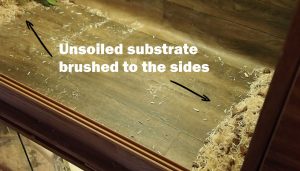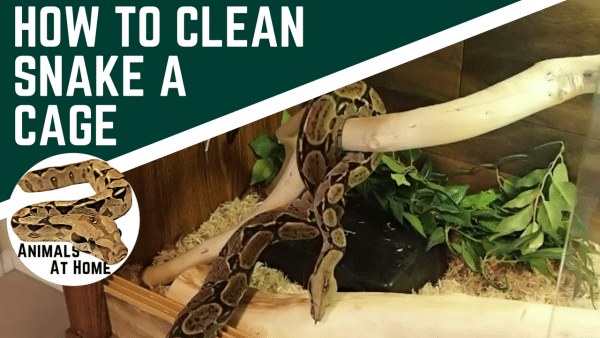How to clean a snake tank? Well there is definitely more than one way to do this but I will layout the way I go about it and the reasons why!
SCROLL TO THE BOTTOM FOR A FREE SNAKE CARE LOGBOOK!
Spot Clean or Full Tank Clean?
Spot Clean: When people use the term “spot clean” they essentially mean they remove feces & waste when the see it. Basically the same thing you see people do with their dogs when they take dumps in the park.
During a typical spot clean, the owner scoops out the waste (and usually some of the substrate) throws it out and moves on to the next enclosure. This is a quick method for removing waste, especially if you have many animals to clean.
People who subscribe to this method normally do a full tank clean every few weeks so they can wipe down the floor, and replace the substrate etc. as spot cleaning does not normally take care of all the waste (especially urates).
Full Tank Clean: The other common way people clean their snake’s tank is by doing a full clean. In other words, they pull everything out (animal, decor, water dish, etc), throw all the old substrate out, and then sanitize the floor and the walls. Once clean, they re-add fresh substrate, decor and of course the animal!
This method is common for tanks with a paper towel or newspaper substrate because the urates are not contained very well i.e. snake pee tends to spread out over a larger foot print.
So what is the better of the two methods? In my opinion: neither!

How to Clean a Snake Tank-The Hybrid Method:
The method I use is a combination of both a “spot clean” and a “full clean.” First, let’s take a look at the reasons I don’t like the spot clean and full clean methods.
Why I Don’t Spot Clean:
Urates tend to remain in the enclosure. Feces are very easy to scoop up in a spot clean but urates (snake urine, which is both solid white clumps and liquid) are harder to pick up because the liquid seeps into the surrounding substrate.
This can leave the offensive smell of snake urine inside the enclosure. This is a very bad smell. If you’ve ever been to a reptile breeder or pet shop that doesn’t do a good job cleaning, the smell of snake pee will hit you like a truck when you walk into the door. I do not want my office smelling that way (the room I keep my snakes).
Buy a Shirt, Help save the Rainforest! Learn More by clicking the shirt below:
Why I don’t do a Full Clean
There are a few reasons why I don’t like to do a full clean of my snake enclosures every time they defecate. The first (and less important of the two) is to save time and money, doing a full cleaning takes more time and you end up going through way more substrate because you replace all the bedding every time you clean.
The real reason I don’t like doing a full cleaning is because I think it is important to keep the snake’s environment as consistent as possible. Snakes are very sensitive to their environment, especially due to their powerful sense of smell. Drastically changing a snakes environment can actually induce a stress response in the animal.
Think of it this way— your snake has been crawling and borrowing all over its substrate and decor for weeks, it becomes familiar with the smells of the enclosure. I also think (me speculating) that the animal itself emits its own body odor throughout the enclosure, an odor which that maybe we can’t perceive but it can. In other words, its enclosure “smells like home.”
When you perform a full clean, you completely strip all of that away in one fell swoop. This thrusts the animal into a brand new environment, an environment it has not explored (even if it looks the same, it doesn’t smell the same), an environment that may not be safe. Hence a stress response. Take a listen to this HerpNation Podcast @ 45:10 ,the whole podcast is good but the 45 minute mark discusses this in more detail.
In my opinion, the “hybrid” method I use is best of both worlds. It removes all the urates, removing the pee smell and allows most of the substrate to remain in the enclosure to hopefully keep environment slightly more familiar to the animal.
Step by Step How to Clean a Snake Tank
Here are the supplies I use:

- Pail with plastic bag for waste
- Kitty Litter scoop
- Plastic Card to scrap urates
- Exo Terra Spray Bottle
- Paper Towel
- Bleach Solution (roughly 10%)
- Aspen Bedding
What is the best substrate to use? Check out this article: BEST SNAKE SUBSTRATE
STEP 1:
Remove Decor!

STEP TWO:
Remove Animal!

STEP THREE:
Remove feces, urates and substrate! I ONLY remove the substrate that falls within about a 8-10″ radius around where the waste was found. Essentially I am trying to remove all substrate that has absorbed any of the urine.


Once I am left with only unsoiled substrate, I push what is left over to the sides of the enclosure.

STEP FOUR:
Next, I spray the area down with the 10% bleach solution. I let the solution sit for 10-15 minutes to give it time to kill any bacteria.

Then I wipe up the bleach!

STEP FIVE:
Once the bleach is wiped up, I then mist the whole area down again but this time with fresh water. The idea here is that the water is absorbing any leftover bleach solution that remains on the floor of the enclosure.

Once I wipe up the water, I try my best to use my nose to determine if I can either still smell urine, or bleach. If I don’t smell either, I move on!
STEP SIX:
Time to replace the soiled substrate with fresh substrate!

Once the new substrate is in, decor can also be re-added!

STEP SEVEN:
This is a crucial step in my opinion! I know not everyone is going to do this but I highly recommend keeping a logbook. I have attached a PDF copy of the logbook I made and use below. Download it, print it and use it if you like!
Snake care is not complicated, but a lot of the care is “few and far between,” especially feeding and cleaning. A logbook just makes your life easier, and allows you to maintain healthier animals.
After every defecation I always weigh my snakes. Waiting until after they have defecated will allow you to get a more accurate weight, as you will be weighing close to “empty.”

A healthy snake should be always gaining or maintaining their weight (give or take). Of course if you are breeding your animals they will be subject to weight changes but generally you are looking for any unexpected changes in weight. An animal that is loosing weight unexpectedly could be ill, and if that is the case I would consider taking them in to see a vet.

Here is a snapshot of my logbook. First I write in the date, then the weight of the snake, next to the weight in brackets I right how much weight was gained or lost, then I will make a note regarding the waste itself (eg. usually I put an, “N”= normal, but if I notice anything strange or different I will jot that down instead), and finally I put another number in brackets indicating how many days since last defecation.
The particular example above the animal actually lost weight but if you look at the line above you will see why. The day before the snake produced urates only and when I weighed him he was still holding on to 50g of feces.
CLICK HERE to Download FREE Snake Care LogBook

I hope you found this article helpful! Feel free to reach out if you have any questions or just want to say hi! hello@animalsathome.ca



4 Replies to “How to Clean a Snake Tank- 3 Methods”